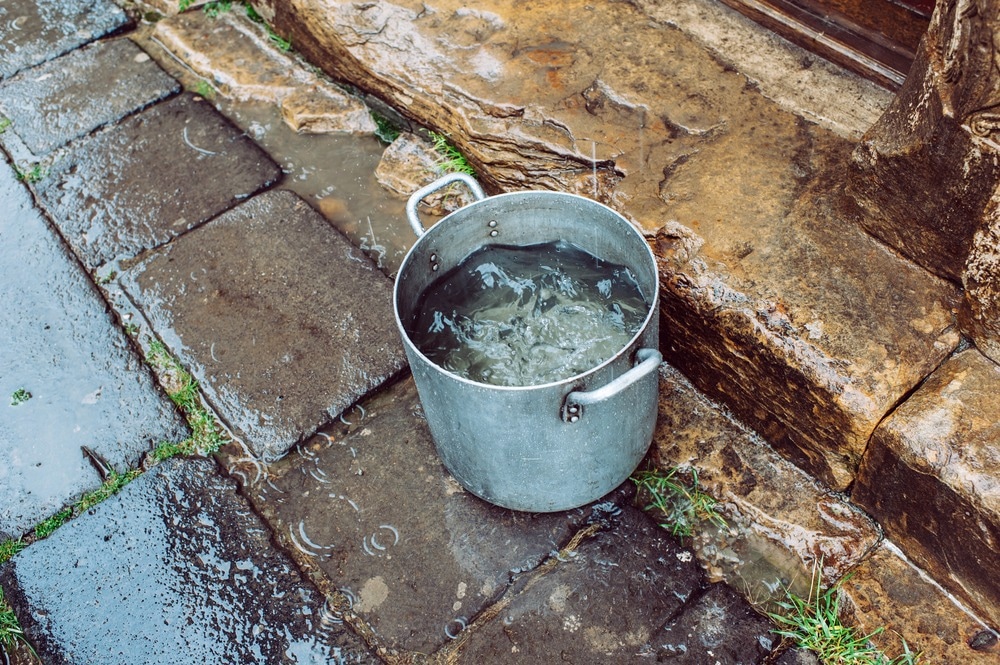A research paper by scientists working at Stockholm University, Sweden, recently disclosed that rainwater is not safe to drink anywhere on the planet. This problem is due to contamination by a class of synthetic chemicals known for their persistence in the environment, so it is not likely to go away.

Image Credit: Anastasia Sholkova/Shutterstock.com
Finding Evidence of Contaminated Rainwater
The authors of the paper, published in the journal Environmental Science and Technology in 2022, discovered evidence of rainwater contamination by chemicals classed as per- and polyfluoroalkyl substances (PFAs) in samples from around the world.
PFAs are industrial chemicals used widely in packaging, shampoo, and make-up until around two decades ago. Although they have largely been phased out of modern manufacturing, these toxic substances have been found to remain in the environment intact for indefinite periods.
The researchers measured levels of commonly found PFA pollution in different environments worldwide, including soil, surface waters, and rainwater. Comparing this data with new guideline levels of PFA contamination that are considered safe by regulatory authorities, the researchers concluded that rainwater is not safe to drink.
Extreme Persistence of Industrial Chemicals in the Environment
The researchers have been studying PFAs for a decade now and, through field and laboratory work, have found that while they were phased out by their major manufacturer (3M) 20 years ago, they are still present in the environment at similar levels.
PFAS, particularly perfluoroalkyl acids (PFAAs), are known for their high persistence. These acids can survive in their surrounding environment for a relatively long period.
With PFAAs, this high persistence rate can cycle in the hydrosphere continuously, even rising into the atmosphere on aerosol droplets of sea spray.
As well as being highly chemically persistent, these substances are frequently cycled through the environment – leading to their ubiquitous spread across the globe. In one cycling process that the team has observed, PFAs rise from the sea to marine air on sea spray aerosol droplets ready to be transported long distances and deposited with rain.
A Shifting Regulatory Landscape
In the last two decades, new research linking PFAs with several health risks, including cancer, immune system problems, raised cholesterol, infertility, and complications with pregnancy and birth, has changed regulations around the substances.
Notably, the guideline values for safe PFA levels in drinking water, surface water, and soil have been significantly lowered in light of the new evidence of their toxicity.
As a result of this consistent lowering of the safe contamination levels, the levels of PFAs in rainwater, surface water, and soil are above the guideline levels worldwide.
In one example, the acceptable safe level of PFA perfluorooctanoic acid (PFOA) – now known to cause cancer – in drinking water has been reduced 37.5 million times in United States guidelines.
While the regulatory environment has changed around PFAs, their associated health risks have always been present. While making rainwater and soil officially unsafe worldwide, the current regulations better reflect the reality of PFA contamination and the risks it is already posing.
Rainwater is Not Safe to Drink and is a Worldwide Problem
Ubiquitously contaminated rainwater is a real problem around the world. Environmental scientist Ian Cousins, a professor at Stockholm University and lead author of the paper, said:
“Although in the industrial world we don’t often drink rainwater, many people around the world expect it to be safe to drink and it supplies many of our drinking water sources.”
But the ubiquity of PFA contamination discovered in this research means that nowhere on Earth receives rainwater that is safe to drink.
The team found that even in the remotest regions of the planet, such as Antarctica and the high plateau of Tibet, rainwater contains too many PFA particles to be considered drinkable, according to the latest guidelines. These extreme locations received rainwater with up to 14 times more PFA contamination than United States guidance considers safe, said researchers.
The Irreversible Effects of Industrial Chemicals
There is minimal scope for reversing the exposure of the planet’s environment to PFAs. The researchers argued that because of this, using and emitting PFAs must be restricted as a matter of urgency.
The paper's authors argued that a boundary has now been crossed with PFA contamination in the environment; the effects of historic PFA pollution are likely irreversible.
The persistence and cyclability of PFAs, sometimes referred to as “forever chemicals” because of these properties, mean that the substances in the hydrosphere and soil will stay there indefinitely.
While the ambient levels of PFAs measured in environmental samples have remained consistent for the last two decades, the levels detected in people’s bodies have dropped significantly during that time.
Testing, filtering, and purifying are essential measures that must be backed up with committed, ongoing investment.
References and Further Reading
AFP (2022) Rainwater unsafe to drink due to chemicals: study. [Online] Phys.org. Available at: https://phys.org/news/2022-08-rainwater-unsafe-due-chemicals.html (Accessed on 15 August 2022).
Cousins, I.T., et al. (2022) Outside the Safe Operating Space of a New Planetary Boundary for Per- and Polyfluoroalkyl Substances (PFAS). Environmental Science and Technology. https://pubs.acs.org/doi/10.1021/acs.est.2c02765
Stockholm University (2022) It’s raining PFAS: even in Antarctica and on the Tibetan plateau rainwater is unsafe to drink. [Online] SU.se. Available at: https://www.su.se/english/news/it-s-raining-pfas-even-in-antarctica-and-on-the-tibetan-plateau-rainwater-is-unsafe-to-drink-1.620735 (Accessed on 15 August 2022).
Disclaimer: The views expressed here are those of the author expressed in their private capacity and do not necessarily represent the views of AZoM.com Limited T/A AZoNetwork the owner and operator of this website. This disclaimer forms part of the Terms and conditions of use of this website.